Vue 2.x 组件通信方式,初学者也能看懂
Vue 2.x 中组件通信方式那么多,究竟应该如何选择?
组件通信方式
组件的关系
组件关系可归类为:
- 父子关系组件
- 非父子组件之间通信(兄弟组件、隔代关系组件)
父子组件通信
案例
为了方便初学者理解,我们定义这样一个场景:
- 父亲(Father)在外赚钱,增加家庭资产;父亲资产即家庭资产。
- 孩子(Child)消费,减少家庭资产。
- 母亲(Mother)调度家庭资产,作为父组件。
- 父亲与孩子作为子组件。
具体代码如下:
// App.vue
<template>
<div id="app">
<mother />
</div>
</template>
<script>
import Mother from './components/Mother.vue'
export default {
name: 'App',
components: {
Mother
},
};
</script>// Mother.vue 父组件
<template>
<div>
<h1>家庭资产:{{ fatherMoney }}</h1>
<father :fatherMoney="fatherMoney" @earnMoney="earnMoney" />
<child :childMoney="childMoney" @getMoney="getMoney" />
</div>
</template>
<script>
import Father from './Father.vue'
import Child from './Child.vue'
export default {
name: 'Mother',
components: {
Father,
Child
},
data() {
return {
fatherMoney: 3000,
childMoney: 0
}
},
methods: {
earnMoney(money) {
this.fatherMoney += money
},
getMoney(money) {
this.fatherMoney -= money
this.childMoney += money
}
}
}
</script>// Father.vue 子组件
<template>
<div>
<h2>父亲资产:{{ fatherMoney }}</h2>
<button @click="earnMoney">赚钱</button>
</div>
</template>
<script>
export default {
name: 'Father',
props: {
fatherMoney: Number
},
methods: {
earnMoney() {
this.$emit("earnMoney", 100)
}
}
}
</script>// Child.vue 子组件
<template>
<div>
<h2>子女资产:{{ childMoney }}</h2>
<button @click="getMoney">拿零花钱</button>
<button @click="consumeSecretly">自己偷偷消费</button>
</div>
</template>
<script>
export default {
name: 'Child',
props: {
childMoney: Number
},
methods: {
getMoney() {
this.$emit('getMoney', 50)
},
consumeSecretly() {
this.childMoney -= 50
}
}
}
</script>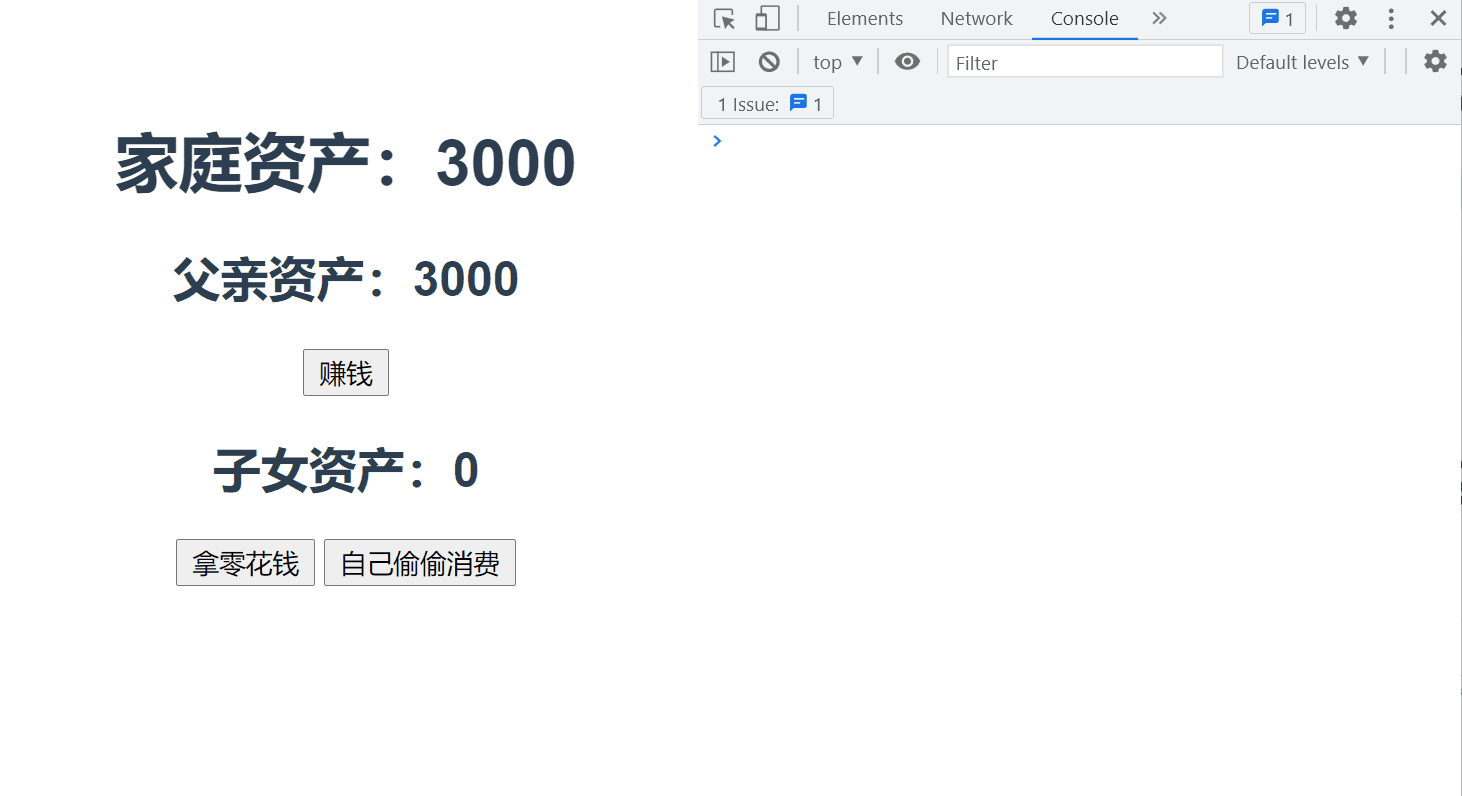
props
父组件通过props的方式向子组件传递数据。
prop 只可以从上一级组件传递到下一级组件(父子组件),即所谓的单向数据流。每次父级组件发生变更时,子组件中所有的 prop 都将会刷新为最新的值。而且 prop 只读,在子组件内部不可被修改。如果修改,修改无效且 Vue 会在浏览器的控制台中发出警告,如案例中图所示。
$emit / v-on
子组件通过$emit 向父组件通信。
子组件可以通过调用内建的 $emit 方法并传入事件名称来触发父组件中事件,父组件由v-on绑定的事件监听器接收该事件并执行相应的操作。
.sync 修饰符
在有些情况下,我们可能需要对一个 prop 进行“双向绑定”。不幸的是,真正的双向绑定会带来维护上的问题,因为子组件可以变更父组件,且在父组件和子组件两侧都没有明显的变更来源。
通过.sync修饰符,可以不需要在子组件内建$emit方法,只通过父组件v-on绑定事件监听器来实现子组件向父组件通信。
为了更好理解,我们修改代码如下:
// Father.vue 子组件
<button @click="$emit('update:fatherMoney', 1000)">买彩票</button> // 不要理会逻辑上的漏洞,反正按了钱就变成 1000
<button @click="$emit('update:fatherMoney', fatherMoney + 100)">
赚钱
</button>// Mother.vue 父组件
// 此处,@update:fatherMoney 绑定的箭头函数无论是否抽离到 methods,都不影响效果。
<father
:fatherMoney="fatherMoney"
@update:fatherMoney="
(money) => {
this.fatherMoney = money;
}
"
/>点击买彩票按钮,会发现fatherMoney变为了1000;点击赚钱按钮,发现fatherMoney累加100。
再次修改代码如下,使用.sync语法糖,效果仍旧。
// Mother.vue 父组件
<father :fatherMoney.sync="fatherMoney" />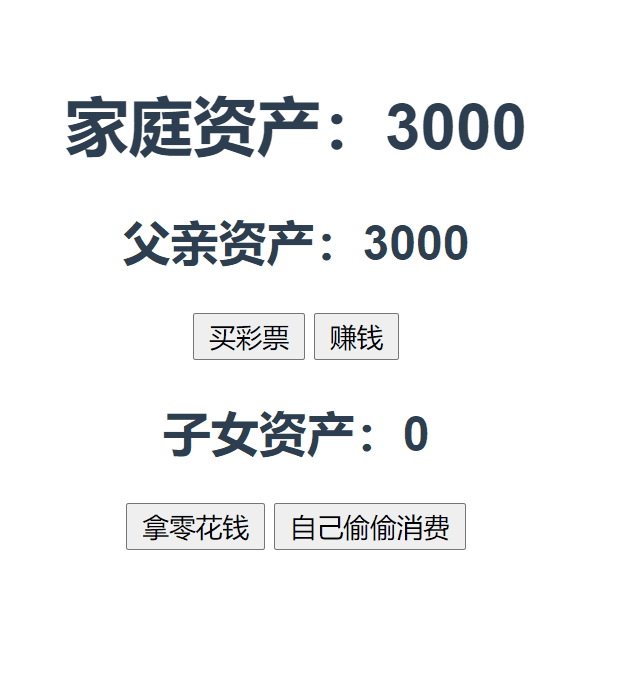
v-model
在.sync中提到真正的双向绑定会带来维护上的问题,理所当然,双向绑定同样可以实现父子组件通信。一个组件上的 v-model 默认会利用名为 value 的 prop 和名为 input 的事件,我们修改代码如下:
// Father.vue 子组件
<template>
<div>
<h2>父亲资产:{{ value }}</h2>
<button @click="$emit('input', 1000)">买彩票</button>
<button @click="$emit('input', value + 100)">
赚钱
</button>
</div>
</template>
<script>
export default {
name: 'Father',
props: {
value: Number
}
}
</script>// Mother.vue 父组件
<father v-model="fatherMoney" />代码仍旧可以实现同样的效果。这里我们拓展一下,根据对v-model的定义,不使用v-model,修改代码如下:
// Father.vue 子组件
<template>
<div>
<h2>父亲资产:{{ value }}</h2>
<button @click="$emit('input', 100)">赚钱</button>
</div>
</template>
<script>
export default {
name: 'Father',
props: {
value: Number
}
}
</script>// Mother.vue 父组件
<template>
<div>
<h1>家庭资产:{{ fatherMoney }}</h1>
<father :value="fatherMoney" @input="earnMoney" />
<child :childMoney="childMoney" @getMoney="getMoney" />
</div>
</template>
<script>
import Father from './Father.vue'
import Child from './Child.vue'
export default {
name: 'Mother',
components: {
Father,
Child
},
data() {
return {
fatherMoney: 3000,
childMoney: 0
}
},
methods: {
earnMoney(money) {
this.fatherMoney += money
}
}
}
</script>点击赚钱按钮,家庭资产同样每次增加100。我们发现显式地利用名为 value 的 prop 和名为 input 的事件,达到了与v-model同样的效果。
ref
ref 被用来给元素或子组件注册引用信息。引用信息将会注册在父组件的 $refs 对象上。如果在普通的 DOM 元素上使用,引用指向的就是 DOM 元素;如果用在子组件上,引用就指向组件实例。
因此可以通过ref拿到实例对象,进而拿到子组件中的数据和方法。
// Mother.vue 父组件
<template>
<div>
<father ref="father" />
</div>
</template>
<script>
import Father from './Father.vue'
export default {
name: 'Mother',
components: {
Father
},
mounted(){
console.log(`拿到了father的私房钱:${this.$refs.father.caseDough}`)
}
}
</script>// Father.vue 子组件
<template>
<div>
<h2>父亲资产:{{ caseDough }}</h2>
</div>
</template>
<script>
export default {
name: 'Father',
data(){
return {
caseDough: 500
}
}
}
</script>隔代组件通信
案例
这里我们同样定义一个场景:
- 爷爷(Grandpa)拥有资产
- 父亲(Father)继承爷爷的资产
- 孩子(Child)继承父亲的资产
- 爷爷作为组件组件,父亲作为父组件,孩子作为子组件
具体代码如下:
// App.vue
<template>
<div id="app">
<grandpa />
</div>
</template>
<script>
import Grandpa from './components/Grandpa.vue'
export default {
name: 'App',
components: {
Grandpa
},
};
</script>// Grandpa.vue 祖先组件
<template>
<div>
<h1>爷爷的资产:{{ grandpaMoney }}</h1>
<father
:money="grandpaMoney"
@spendMoney="
(bill) => {
grandpaMoney -= bill
}
"
/>
</div>
</template>
<script>
import Father from './Father.vue'
export default {
name: 'Grandpa',
data() {
return {
grandpaMoney: 10000,
}
},
components: {
Father
}
}
</script>// Father.vue 父组件
<template>
<div>
<h2>爸爸继承爷爷的资产: {{ money }}</h2>
<child
:money="money"
@spendMoney="
(bill) => {
$emit('spendMoney', bill);
}
"
/>
</div>
</template>
<script>
import Child from './Child.vue'
export default {
name: 'Father',
props: {
money: Number
},
components: {
Child
}
}
</script>// Child.vue 孙组件
<template>
<div>
<h2>子女继承爸爸的资产:{{ money }}</h2>
<button @click="consume">孩子消费</button>
</div>
</template>
<script>
export default {
name: 'Child',
props: {
money: Number
},
methods: {
consume() {
this.$emit('spendMoney', 100)
}
}
}
</script>具体效果如下图:
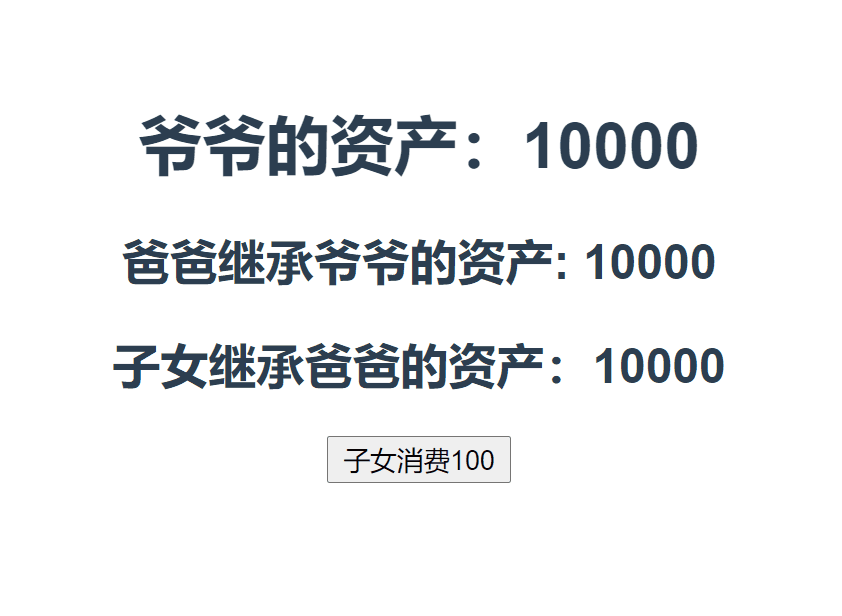
props
与父子组件通信思路相同,props将数据一级一级向下传递。案例中使用的就是props,父组件作为中间桥梁沟通祖先组件与孙组件。
$parent
$parent会获取父实例,如果当前实例有的话。我们修改代码如下:
// Child.vue 孙组件
<template>
<div>
<h2>子女继承爸爸的资产:{{ money }}</h2>
<button @click="consume">子女消费100</button>
</div>
</template>
<script>
export default {
name: 'Child',
props: {
money: Number
},
methods: {
consume() {
console.log(this.$parent)
this.$parent.$emit('spendMoney',100)
}
}
}
</script>// Father.vue 父组件
<template>
<div>
<h2>爸爸继承爷爷的资产: {{ money }}</h2>
<child
:money="money"
@spendMoney="
(bill) => {
$emit('spendMoney', bill);
}
"
/>
</div>
</template>
<script>
import Child from './Child.vue'
export default {
name: 'Father',
props: {
money: Number
},
components: {
Child
},
data() {
return {
test: 123
}
}
}
</script>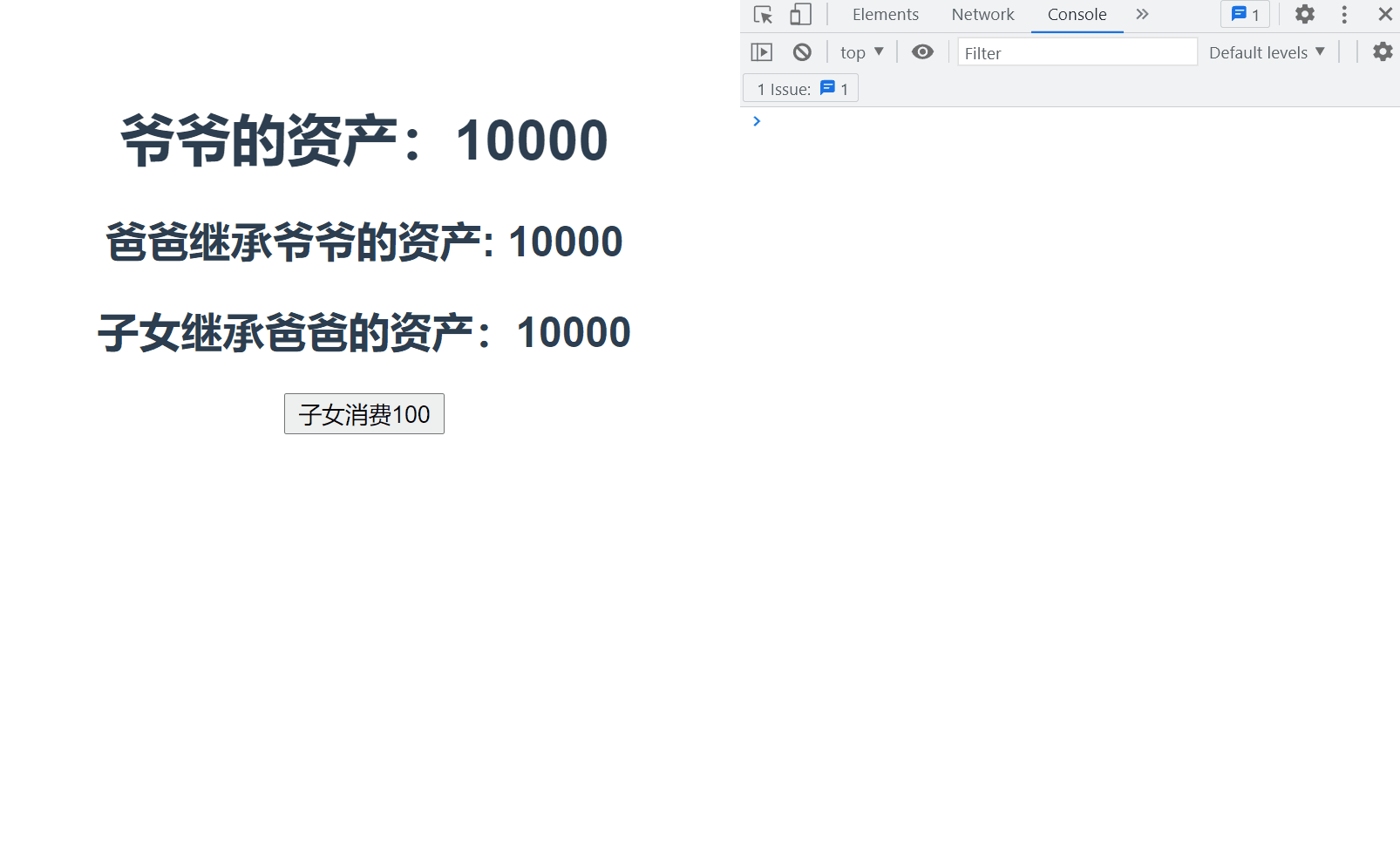
这里我们通过$parent可以触发在v-on绑定的事件。除此之外,$parent还能获得许多其他的参数,具体看下图。
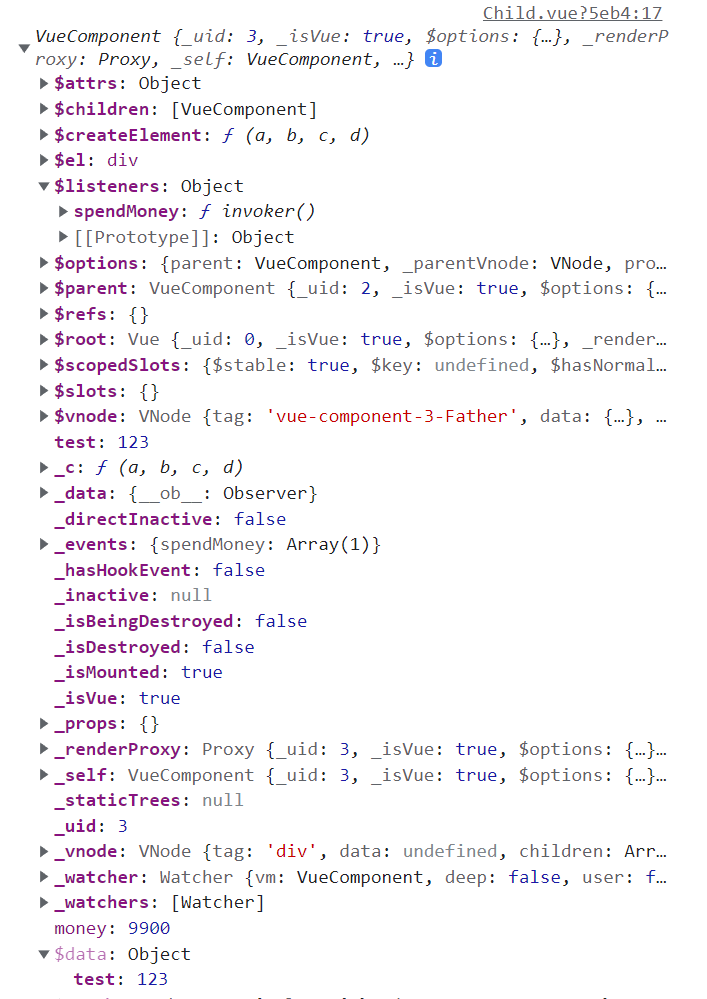
可以看到,在parent实例中同样有一个parent参数。很自然会想到,能否通过调用$parent.$parent里的方法来实现不触发父组件中的事件来直接修改数据。于是,再次修改代码如下:
// Grandpa.vue 祖先组件
<template>
<div>
<h1>爷爷的资产:{{ grandpaMoney }}</h1>
<father :money="grandpaMoney" />
</div>
</template>
<script>
import Father from './Father.vue'
export default {
name: 'Grandpa',
data() {
return {
grandpaMoney: 10000,
}
},
components: {
Father
},
methods: {
spendMoney(bill) {
this.grandpaMoney -= bill
}
}
}
</script>// Father.vue 父组件
<template>
<div>
<h2>爸爸继承爷爷的资产: {{ money }}</h2>
<child :money="money" />
</div>
</template>
<script>
import Child from './Child.vue'
export default {
name: 'Father',
props: {
money: Number
},
components: {
Child
}
}
</script>// Child.vue 孙组件
<template>
<div>
<h2>子女继承爸爸的资产:{{ money }}</h2>
<button @click="consume">子女消费100</button>
</div>
</template>
<script>
export default {
name: 'Child',
props: {
money: Number
},
methods: {
consume() {
this.$parent.$parent.spendMoney(100)
}
}
}
</script>同样可以,也就是说可以通过this.$parent.$partent...这样的方法来一直向上调用指定层级中的方法来修改数据,当然这种方法已经不再局限于传值了。
如果层级过多的话,this.$parent.$partent...这种方式传值显得有些愚蠢。在 Vue 1.0 中我们可以使用$dispatch/$broadcast。
$children
$children获得的是当前实例的直接子组件(数组)。**需要注意 $children 并不保证顺序,也不是响应式的。**实际用法与$parent类似。
$dispatch / $broadcast (Vue 1.0)
$dispatch用来派发事件,首先在实例上触发它,然后沿着父链向上冒泡在触发一个监听器后停止,除非它返回 true。附加参数都会传给监听器回调。
$broadcast用来广播事件,通知给当前实例的全部后代。因为后代有多个枝杈,事件将沿着各“路径”通知。每条路径上的通知在触发一个监听器后停止,除非它返回 true。
需要声明的是,这两个方法在 Vue2.0 被弃用。官方的解释是:“因为基于组件树结构的事件流方式实在是让人难以理解,并且在组件结构扩展的过程中会变得越来越脆弱。这种事件方式确实不太好,我们也不希望在以后让开发者们太痛苦。并且 $dispatch 和 $broadcast 也没有解决兄弟组件间的通信问题。”
但在一些地方我们仍可以看到通过在原型链上拓展实现广播/派发。我们自己来封装eventDispatch和eventBroadcast,新建文件夹src/extends,在里面新建event.js和index.js。
// event.js
export default function (Vue) {
Vue.prototype.$eventDispatch = function (eventName, value) {
// 在 Vue 组件内调用,this 指向 Vue 组件实例,因此可以获取的实例的 $parent
let parent = this.$parent;
// 沿着父链向上冒泡
while (parent) {
// 附加参数都会传给监听器回调。
parent.$emit(eventName, value);
parent = parent.$parent;
}
};
}// extends/index.js
import eventExtend from "./event";
export { eventExtend };在main.js中引入并拿到 Vue 的构造函数
// main.js
import Vue from 'vue';
import App from './App';
import { eventExtend } from './extends'
// 拿到 Vue 的构造函数
eventExtend(Vue);
Vue.config.productionTip = false;
new Vue({
el: '#app',
components: { App },
template: '<App/>',
});接着修改Child.vue、Father.vue以及Grandpa.vue
// Child.vue 孙组件
<template>
<div>
<h2>子女继承爸爸的资产:{{ money }}</h2>
<button @click="consume">子女消费100</button>
</div>
</template>
<script>
export default {
name: 'Child',
props: {
money: Number
},
methods: {
consume() {
this.$eventDispatch('spendMoney',100)
}
}
}
</script>// Father.vue 父组件
<template>
<div>
<h2>爸爸继承爷爷的资产: {{ money }}</h2>
<child
:money="money"
@spendMoney="
(bill) => {
$emit('spendMoney', bill);
}
"
/>
</div>
</template>
<script>
import Child from './Child.vue'
export default {
name: 'Father',
props: {
money: Number
},
components: {
Child
}
}
</script>// Grandpa.vue 祖先组件
<template>
<div>
<h1>爷爷的资产:{{ grandpaMoney }}</h1>
<father :money="grandpaMoney" @spendMoney="spendMoney" />
</div>
</template>
<script>
import Father from './Father.vue'
export default {
name: 'Grandpa',
data() {
return {
grandpaMoney: 10000,
}
},
components: {
Father
},
methods: {
spendMoney(bill) {
this.grandpaMoney -= bill
}
}
}
</script>至此,实现了通过拓展原型链模拟$dispatch效果。接下来模拟$broadcast效果,修改代码如下:
// event.js
export default function (Vue) {
Vue.prototype.$eventDispatch = function (eventName, value) {
// 在 Vue 组件内调用,this 指向 Vue 组件实例,因此可以获取的实例的 $parent
let parent = this.$parent;
// 沿着父链向上冒泡
while (parent) {
// 附加参数都会传给监听器回调。
parent.$emit(eventName, value);
parent = parent.$parent;
}
};
Vue.prototype.$eventBroadcast = function (eventName, value) {
const bc = (children) => {
children.map(c => {
c.$emit(eventName, value)
if (c.$children) {
bc(c.$children)
}
})
}
bc(this.$children)
}
}// Grandpa.vue 祖先组件
<template>
<div>
<h1>爷爷的资产:{{ grandpaMoney }}</h1>
<father :money="grandpaMoney" @spendMoney="spendMoney" @notice="notice" />
</div>
</template>
<script>
import Father from './Father.vue'
export default {
name: 'Grandpa',
data() {
return {
grandpaMoney: 10000,
}
},
components: {
Father
},
methods: {
spendMoney(bill) {
this.grandpaMoney -= bill
this.$eventBroadcast('notice')
},
notice() {
console.log('父亲用钱了');
}
}
}
</script>// Father.vue 父组件
<template>
<div>
<h2>爸爸继承爷爷的资产: {{ money }}</h2>
<child
:money="money"
@spendMoney="
(bill) => {
$emit('spendMoney', bill);
}
"
@notice="notice"
/>
</div>
</template>
<script>
import Child from './Child.vue'
export default {
name: 'Father',
props: {
money: Number
},
components: {
Child
},
methods: {
notice() {
console.log('孩子用钱了')
}
}
}
</script>// Child.vue 孙组件
<template>
<div>
<h2>子女继承爸爸的资产:{{ money }}</h2>
<button @click="consume">子女消费100</button>
</div>
</template>
<script>
export default {
name: 'Child',
props: {
money: Number
},
methods: {
consume() {
this.$eventDispatch('spendMoney',100)
}
}
}
</script>实现效果如下图所示:
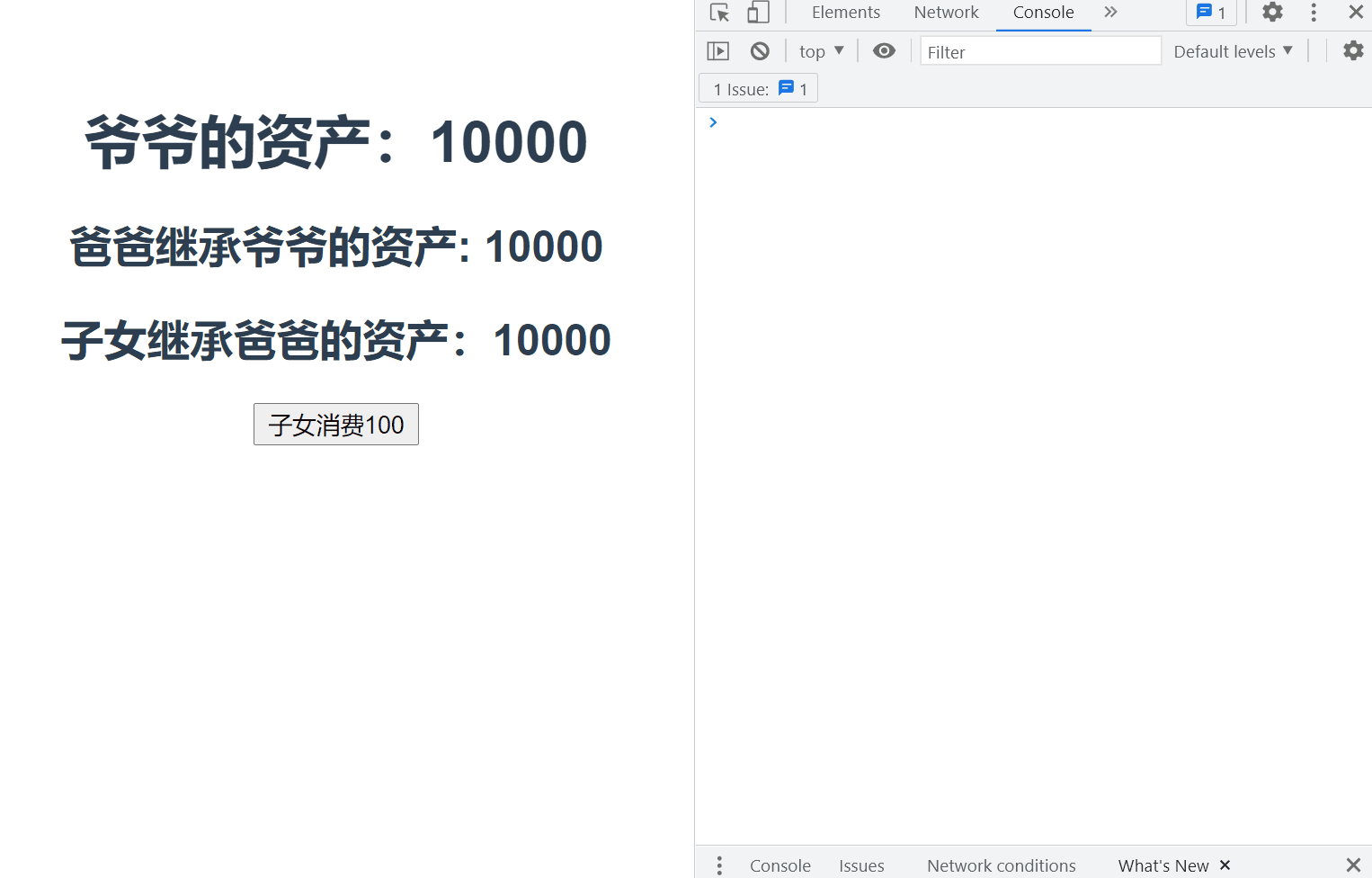
$attrs / $listeners
$attrs包含了父作用域中不作为 prop 被识别 (且获取) 的 attribute 绑定 (class 和 style 除外)。当一个组件没有声明任何 prop 时,这里会包含所有父作用域的绑定 (class 和 style 除外),并且可以通过 v-bind="$attrs" 传入内部组件。
$listeners包含了父作用域中的 (不含 .native 修饰器的) v-on 事件监听器。它可以通过 v-on="$listeners" 传入内部组件。
同样为了方便理解,代码修改如下:
// Grandpa.vue 祖先组件
<template>
<div>
<father
:name="name"
:age="age"
:hobby="hobby"
:homeTown="homeTown"
@notice="notice"
/>
</div>
</template>
<script>
import Father from './Father.vue'
export default {
name: 'Grandpa',
components: {
Father
},
data() {
return {
name: '无声',
age: 18,
hobby: '下棋',
homeTown: '温州'
}
},
methods: {
notice() {
console.log('回家吃饭')
}
}
}
</script>// Father.vue 父组件
<template>
<div>
<child v-bind="$attrs" v-on="$listeners" />
</div>
</template>
<script>
import Child from './Child.vue'
export default {
name: 'Father',
components: {
Child
}
}
</script>// Child.vue 孙组件
<template>
<div>
<h1>姓名:{{ this.$attrs.name }}</h1>
<h1>年龄:{{ this.$attrs.age }}</h1>
<h1>爱好:{{ this.$attrs.hobby }}</h1>
<h1>家乡:{{ this.$attrs.homeTown }}</h1>
</div>
</template>
<script>
export default {
name: 'Child',
mounted() {
this.$listeners.notice()
}
}
</script>效果如下图所示:
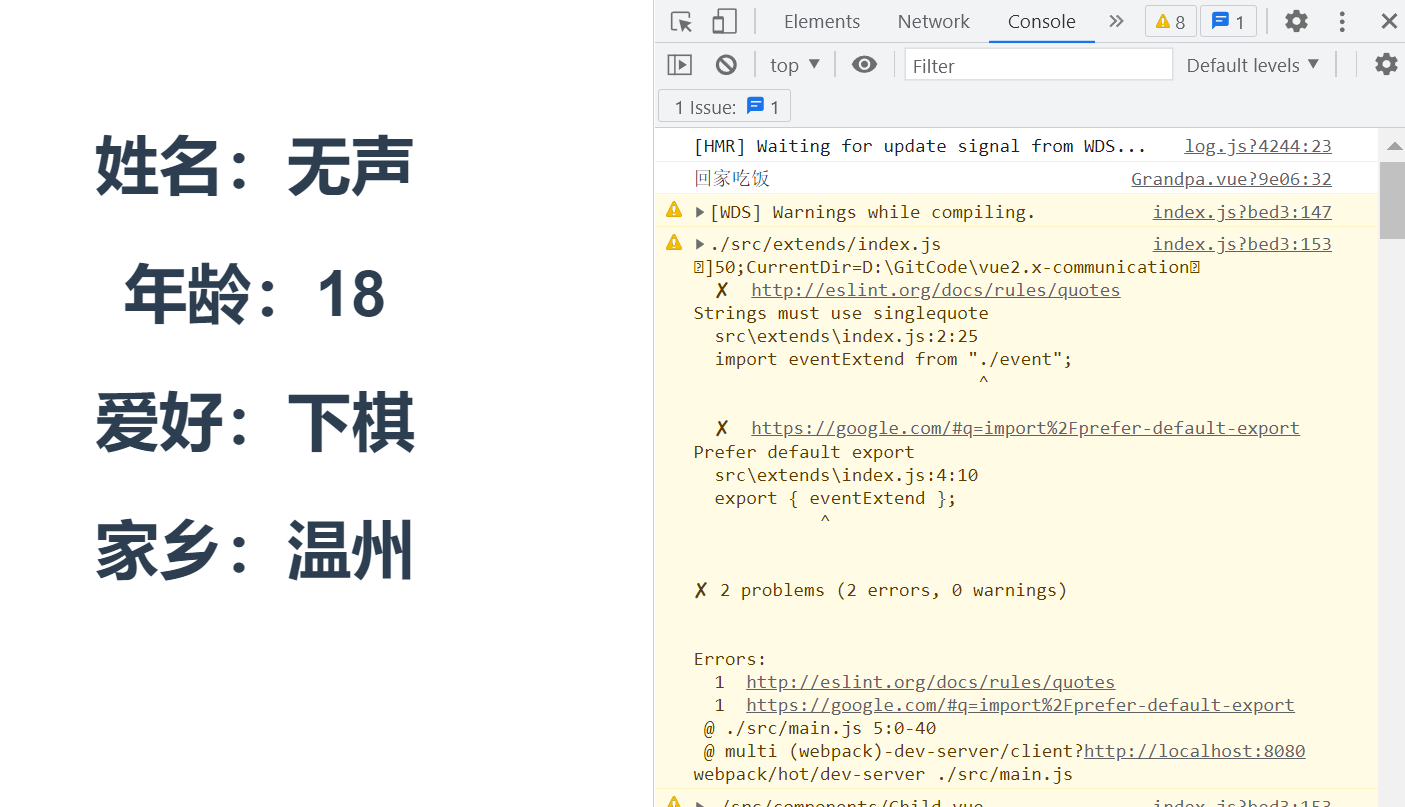
provide / inject
这对选项需要一起使用,以允许一个祖先组件向其所有子孙后代注入一个依赖,不论组件层次有多深,并在其上下游关系成立的时间里始终生效。
// Grandpa.vue 祖先组件
<template>
<div class="grandpa">
<father />
</div>
</template>
<script>
import Father from './Father.vue'
export default {
provide() {
return {
grandpa: this
}
},
name: 'Grandpa',
components: {
Father
},
data() {
return {
name: '无声',
age: 18,
hobby: '下棋',
homeTown: '温州'
}
},
methods: {
notice() {
console.log('回家吃饭')
}
}
}
</script>// Child.vue 孙组件,Fahter.vue 不做额外修改。
<template>
<div class="child"></div>
</template>
<script>
export default {
inject: ['grandpa'],
name: 'Child',
mounted() {
console.log(this.grandpa)
console.log(this.grandpa.name);
}
}
</script>// 控制台输出
VueComponent {_uid: 2, _isVue: true, $options: {…}, _renderProxy: Proxy, _self: VueComponent, …}
无声可以看到,通过provide和inject在 Child.vue 中拿到了 Grandpa.vue 注入的实例对象。
注意:
provide和inject绑定并不是可响应的。这是刻意为之的。然而,如果你传入了一个可监听的对象,那么其对象的 property 还是可响应的。
兄弟组件通信
案例
新建 Child.vue 同级文件 Child.vue2
// Father.vue 父组件
<template>
<div class="father" ref="father">
<child />
<child2 />
</div>
</template>
<script>
import Child from './Child.vue'
import Child2 from './Child2.vue'
export default {
name: 'Father',
components: {
Child,
Child2
}
}
</script>父组件中转
既然能实现子向父、父向子传值,那么理所当然地会想通过父组件将数据进中转。例如,本案例中可以让 Child 先将数据传递给 Father,再由 Father 传递给 Child2。具体实现的方法很多,这里不再赘述,看不懂的同学回到上面再复习一下。
eventBus
eventBus 又称为事件总线,在vue中可以使用它来作为沟通桥梁的概念, 就像是所有组件共用相同的事件中心,可以向该中心注册发送事件或接收事件, 所以组件都可以通知其他组件。
与之前实现广播/派发类似,我们在原型链上拓展一个eventBus方法,修改代码如下:
// event.js
export default function (Vue) {
// 通过在原型链上注册一个 Vue 实例,得到使用 Vue 方法的能力
Vue.prototype.$eventBus = new Vue()
}// Child.vue 孙组件
<template>
<div class="child"></div>
</template>
<script>
export default {
inject: ['grandpa'],
name: 'Child',
mounted() {
this.$eventBus.$on('childTouch', param => {
console.log(param)
})
}
}
</script>// Child2.vue
<template>
<div></div>
</template>
<script>
export default {
name: 'Child2',
mounted(){
this.$eventBus.$emit('childTouch','Child2 来找你了')
}
}
</script>可以看到控制台输出结果如下:
Child2 来找你了除此之外,通过eventBus我们还能实现父子组件及祖先组件通信,但是要确保$on要在$emit之前执行。
Vuex
Vuex 是一个专为 Vue.js 应用程序开发的状态管理模式。Vuex 解决了多个视图依赖于同一状态和来自不同视图的行为需要变更同一状态的问题,将开发者的精力聚焦于数据的更新而不是数据在组件之间的传递上。
Vuex 和后面提到的localStorage/ sessionStorage的传值可以涵盖父子、祖先、兄弟。Vuex 的官方文档中定义其是采用集中式存储来管理组件的状态,并以相应的规则保证状态以一种可预测的方式发生变化。我认为localStorage/ sessionStorage也是如此。
简单来说,日常开发中,所有的传值都可以通过 Vuex 解决,但只是用 Vuex 来做传值显得有些大材小用。此处不对 Vuex 做展开,一方面内容太多,另一方面我自己对于 Vuex 的也只是一知半解。
localStorage / sessionStorage
这种通信比较简单,缺点是数据和状态比较混乱,不太容易维护。 window.localStorage.getItem(key)获取数据,window.localStorage.setItem(key,value)存储数据。
注意用
JSON.parse()/JSON.stringify()做数据格式转换 。localStorage/sessionStorage可以结合 Vuex, 实现数据的持久化,同时使用 Vuex 解决数据和状态混乱问题。
如何选择通信方式?
了解了那么多通信方式,回到开头的问题,到底要选择哪一种?
对于中大型单页应用开发者来说,Vuex 是自然而然的选择,可以更好地在组件外部管理状态。而在不使用 Vuex 的情况下,则见仁见智(确实没找到特别权威的排序),下面仅代表个人观点:
| 使用时选择优先级(仅代表个人观点) | |
|---|---|
| 父子组件通信 | props/$emit > .sync > v-model > ref |
| 隔代组件通信 | props/$emit > $parent / $children > provide / inject > $attrs / $listeners |
| 兄弟组件通信 | 父组件中转 > eventBus |
localStorage / sessionStorage | 优先考虑 Vuex,我基本只在需要持久化时才会用。 |
可以看到,相比之下,我倾向使用麻烦一些的方法,但传值时数据来源更显式,代码的可维护性更好。